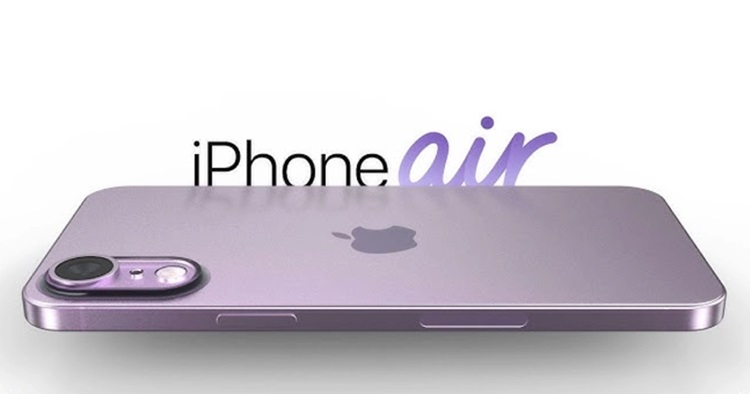Apple iPhone Air: The Ultra-Thin Revolution – A Complete Review


The iPhone Air was announced on September 9 and will be available from September 19. It is a totally new product of Apple. Sporting a bold design in a thin body, it feels more like a piece of the future you can buy today. Let's take a look at the main features, specifications, merits, demerits and expected pricing of the iPhone Air in Bangladesh.
Key Features of iPhone Air
Design and Build Quality
The iPhone Air makes an instant impression the moment you pick it up. It is unbelievably thin at just 5.6 mm and so light at 165 g that you almost forget you are holding a flagship phone. Yet, it does not feel flimsy at all. Apple has combined Ceramic Shield 2 glass on the front and back with a Grade 5 titanium frame, giving it both elegance and durability in equal measure.
The IP68 rating is reassuring too – knowing it can handle a 6-metre underwater adventure for half an hour gives you that peace of mind for real-world accidents. Those curved edges and matte back finish make it surprisingly comfortable to hold despite the larger screen, and honestly, the anti-reflective coating and precision titanium work show Apple's obsessive attention to detail. It genuinely feels like holding something luxurious that is also ready for whatever life throws at it.
Display Quality
The iPhone Air features a 6.5-inch LTPO Super Retina XDR OLED display, and it is nothing short of stunning. With a 120 Hz refresh rate, HDR10, Dolby Vision, and up to 3000 nits peak brightness, this screen is designed to impress you anywhere, indoors or outdoors. Colours look punchy yet natural, blacks are deep, and contrast is excellent.
For streaming, the higher peak brightness makes HDR content stand out beautifully, giving movies and shows a cinematic feel. The 1260 by 2736 pixels resolution, 19.5:9 ratio and slim bezels also make it highly immersive, while the 460 ppi density ensures crisp text and sharp images. Apple’s use of Ceramic Shield 2 with Mohs level 5 hardness and an anti-reflective layer further improves usability, reducing glare during outdoor use. The display feels like one of the biggest selling points of this phone.
Camera Performance
On the camera front, the iPhone Air takes a slightly different approach compared to its Pro siblings. Instead of multiple lenses, it uses a 48 MP wide sensor as its main camera. While it may sound limiting, Apple’s software magic ensures you still get incredible results. The sensor-shift optical image stabilisation and dual-pixel PDAF help capture detailed shots in almost any lighting condition. The primary sensor features an f/1.6 aperture, 26 mm lens width, 1/1.56 lens size, and 1.0 µm sensor size.
Low-light photography is noticeably better thanks to improved Night Mode and HDR. Video recording is equally impressive, with support for 4K at up to 60 fps, Dolby Vision HDR, and even 240 fps slow motion at 1080p. Content creators will find this phone reliable for both casual and semi-professional use.
The 18 MP front camera featuring f/1.9 aperture deserves mention as well. With OIS, PDAF, and support for Dolby Vision HDR, selfies and video calls look sharp and smooth. Apple has also added spatial audio and stereo sound recording, making video calls and vlogs feel more immersive.
Processor Performance
Under the hood, the iPhone Air is powered by the Apple A19 Pro chip built on a 3nm process. This chipset is not just powerful—it is efficient. The hexa-core CPU and 5-core Apple GPU work seamlessly to deliver blazing-fast performance across all tasks.
From opening apps instantly to handling intensive video editing, everything feels buttery smooth. Apple has also baked in AI-driven performance optimisations, making tasks like voice recognition, photo processing, and predictive text smarter and faster. Paired with iOS 26, the user experience feels fluid and polished, with minimal lag or slowdowns.
Gaming Performance
Gamers are going to absolutely love what the iPhone Air brings to the table. You can play Call of Duty Mobile and Genshin Impact, and the performance is incredible. That A19 Pro GPU paired with the 120 Hz OLED makes everything look buttery smooth – no stutters or frame drops even during intense battles.
What will really surprise you though is how cool it stays during those marathon gaming sessions. Previous iPhones would get uncomfortably hot, but this one just keeps chugging along without any throttling. The spatial audio and haptic feedback make it feel almost like you are playing on a console – it is that immersive.
Battery Life
At 3149 mAh, the iPhone Air’s battery might sound modest compared to some Android rivals, but Apple’s efficiency magic comes into play. Thanks to the A19 Pro’s power management and iOS 26’s optimisations, the phone delivers all-day battery life with ease. You can expect up to 22 hours of video playback or a full day of heavy social media, gaming, and streaming without constantly reaching for the charger.
Charging is also fast and convenient. The device supports PD2.0 fast charging, which gets you 50% in just 30 minutes. Wireless charging via MagSafe 3.0 and Qi2 is supported as well, offering 15W speeds in China and 20W elsewhere. For added flexibility, Apple even included reverse wired charging at 4.5 W, allowing you to juice up accessories like AirPods.
Software and User Interface
Running on iOS 26, the iPhone Air feels intuitive and packed with smart features. Apple has introduced subtle UI refinements, making multitasking smoother and gestures more responsive. The integration of satellite connectivity for SOS, Messages, and Find My gives peace of mind during emergencies.
Face ID continues to be the primary biometric option, now faster and more accurate. The system-level integration of the UWB Gen2 chip also means better connectivity with AirTags and Apple’s expanding ecosystem of devices. It is not just about speed—it is about how seamlessly everything works together.
Storage Options
Apple provides generous storage choices this time around, starting at 256GB with 12GB RAM and going all the way up to 1TB. All models use NVMe storage, ensuring ultra-fast read and write speeds, which is especially helpful when transferring large files or editing videos directly on the device.
The lack of expandable storage is not new, but with these configurations, most users will not feel the pinch. The inclusion of 12GB RAM across all variants also ensures better multitasking, future-proofing the phone for years to come.
Pros and Cons of the Apple iPhone Air
Pros
- Ultra-thin and lightweight design.
- Durable Ceramic Shield 2 glass with a titanium frame.
- Stunning 6.5-inch LTPO XDR OLED with HDR10 and Dolby Vision.
- Powered by the Apple A19 Pro chipset.
- Large storage options: 256GB, 512GB, and 1TB.
- Stereo speakers with immersive sound.
- Fast Face ID unlocking.
- 25W MagSafe wireless charging support.
Cons
- Only a single rear camera.
- No option for expandable storage.
- Smaller 3149 mAh battery compared to rivals.
Price of Apple iPhone Air
The price of the iPhone Air in Bangladesh is expected to start from BDT 150,000.
In a Nutshell
The Apple iPhone Air shines with its slim design, sharp OLED display, and powerful A19 Pro chip but compromises with a single camera and modest battery. It can be a good pick for users who value portability, premium design, and smooth performance. However, heavy photographers or power users seeking bigger batteries may check out other options.
